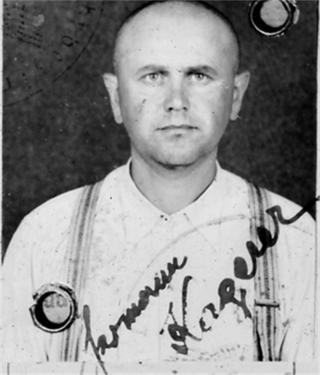Hermann Kagerer

Personalia
Born:
Died:
Profession:
Persecution:
Imprisonment 13.03.1938 - 25.07.1938,
Dachau concentration camp 25.07.1938 - 09.05.1939,
Mauthausen concentration camp 09.05.1939 - 15.11.1940,
Banned from preaching and teaching,
Gau ban
KZ Number:
Memberships
Curriculum Vitae
After attending the episcopal grammar school Collegium Petrinum in Linz-Urfahr and then the state grammar school in Ried i. I., Hermann Kagerer graduated with honors and was called up in 1915 as a "one-year volunteer with the k. u. k. Ersatzbezirkskommando Linz". Ersatzbezirkskommando Linz" in 1915. After completing his officer training, he was deployed with the 14th Infantry Regiment Linz on the Galician front and finally as a lieutenant on the Italian front, where he also fought in the 11th Battle of the Isonzo.
In November 1918, he entered the Linz seminary and was ordained a priest on June 29, 1922 after completing his philosophical and theological training. He initially worked as a cooperator in the Upper Austrian parishes of Waizenkirchen, Sierning and finally in Bad Ischl. In 1929, he decided to become a religious education teacher at the boys' and girls' secondary school in Ried im Innkreis. As president, he also looked after the students of the state grammar school in Ried, who were members of the Christian German Student Association [CDSB]. Here he emphatically tried to make young students aware of the impending doom of National Socialism. From 1936, with the consent of the Bishop of Linz, Jobarmes M. Gföllner (1915-1941), he also became politically active as a functionary of the VF.
On the night of the invasion of the German Wehrmacht on March 12, 1938, his house was searched. As a "politicizing priest", he was arrested "for anti-national socialist activities, especially in student circles". After a few days under house arrest, he was taken to the district court, where he was tortured and questioned further. From here he was taken into Gestapo custody on July 20, 1938 and taken to the Linz police prison. He was then transferred to the Dachau concentration camp without trial.
When the Nazis seized power in Austria, I was arrested on the night of the invasion for my work with the Fatherland Front (in Ried im Innkreis), was taken to the district court in Ried i. I., from there to the police prison in Linz-Mozartstraße, from there with Pastor Just [P. Konrad Just, OCist - 21 863] from Gramastetten to Dachau in the camp bunker. A piece of bread and soup every 4th day. Many beatings, lots of hunger and indescribable hatred. After 40 days, Himmler gave the order that all priests had to be transferred to barrack 15 and so I was sent to the punishment block. [...] We priests were already predestined to carry stones and drive wheelbarrows. As I had always been a handyman, I signed up as a carpenter just to get out of the punishment block.
After being sent to the concentration camp, the priests were generally assigned to the dreaded punishment company, where they had to perform particularly hard physical labor. By the end of 1938, the number of Austrian priest prisoners had increased to 14, followed by nine more in 1939 - they were listed in the camp register as "Reich German". 260 prisoners were transferred to Upper Austria for the construction and expansion of a new concentration camp, including Hermann Kagerer.
On May 9, 1939, Hermann Kagerer was the first priest prisoner to be transferred to the Mauthausen concentration camp.
Here in Mauthausen, he was employed as a stone carrier, wheelbarrow driver, in the quarry operating a compressor, toolsmith, saw filer etc. and finally as a clerk in the effects chamber.
Immediately after the seizure of power in March 1938, I was the first person from the town to be arrested by the SS and incarcerated in the Ried district court. I was then sent from the Ried district court to the Dachau concentration camp and from Dachau to the Mauthausen extermination camp. There I was sentenced to death five times, but with God's help I returned home alive.
Places
Persecution:
Citations
Krause, Peter/Reinelt, Herbert/Schmitt, Helmut (2020): Farbe tragen, Farbe bekennen. Katholische Korporierte in Widerstand und Verfolgung. Teil 2. Kuhl, Manfred (ÖVfStG, Wien) S. 152/153.
